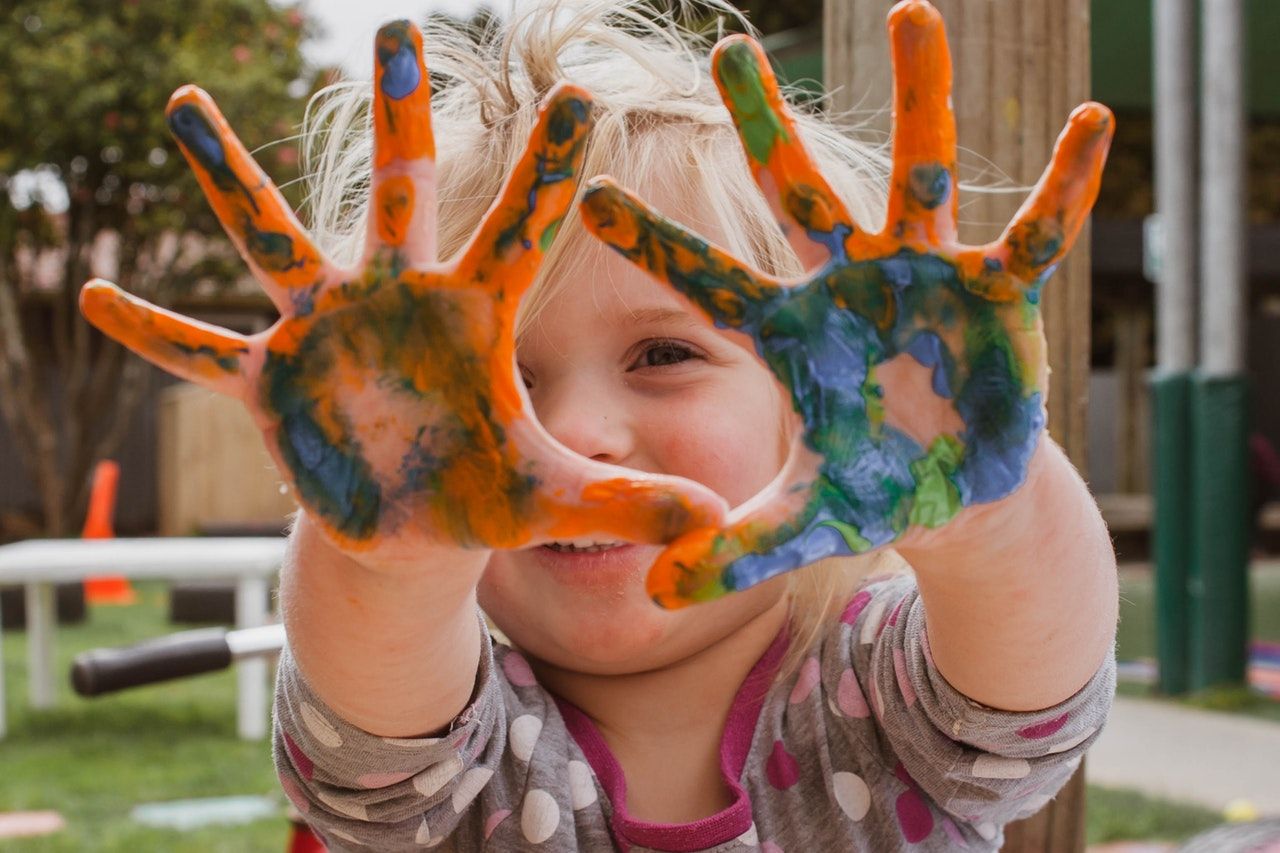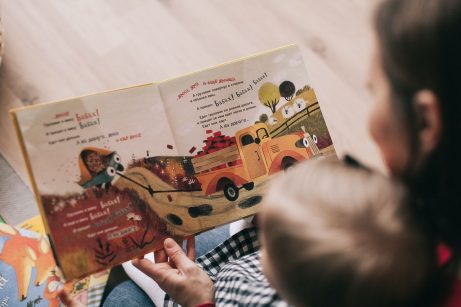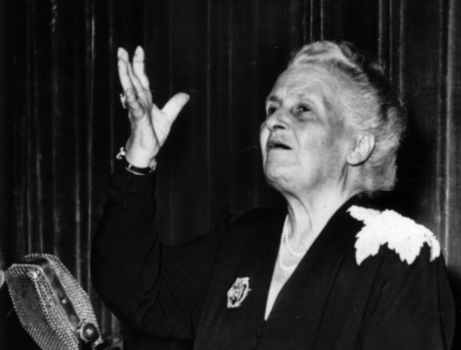Children’s Art

Art and artistic expression are, in Montessori, considered to be one of the fundamental human tendencies. More so, we also know that it forms a crucial aspect of children’s mental development. How do we understand, interpret and support this important activity?
Why do humans create art? As far back as we have any kind of record, we know that all human beings across continents and cultures have behaved in peculiar ways that appear inextricably tied to our way of thinking, living and being. These include singing, dancing, and creating visual art. Even more curiously, although all of these behaviours are shaped and influenced by our experiences, environments and communities – our culture – they emerge automatically even if no one shows us the way.
Visual art, especially in its initial form of scribbling and drawing, seems to be the aspect most closely tied to our mental life, least determined by external factors. All children around the world begin to scribble at almost the same age, in almost the same way. The product of their effort is considered such a close mirror of their mental life that it is accepted as a key diagnostic tool in psychology and psychiatry. Naturally, as Montessorians we should immediately guess at the significance of a universal, autolearned activity that manifests the child’s inner life, not only as a means of insight into the working of the child’s mind but also as a tool of the child’s self-construction.
The task of the adult becomes clear: we must understand the child’s activity, prepare the environment to support it, and take care not to interfere with its natural development. The aim of this article is to provide you with the tools and information to do all three.

Explore the fundamentals of Montessori parenting with this free video by Sylvia Arotin, offering insights and strategies to empower and educate your child.
The Timeline of Children’s Art
Toddler children begin to consciously draw or scribble – that is, purposefully create marks on available surfaces – at the age of 16-18 months old. Curiously, even blind children have been observed to do so – however, without visual feedback, they soon stop. Seeing children, however, repeat this and begin to show satisfaction and enjoyment of the activity. Their control of the drawing implement is, of course, very imperfect at first, but nonetheless they show clear concentration and intention in their work.
Between the age of two and three, figures begin to show in the child’s drawings. The placement of lines and shapes in space becomes conscious and deliberate and gradually, new shapes appear: crosses, triangles and four-sided shapes. Around the age of three the child starts drawing circles and often becomes quite preoccupied with them – as we are in adulthood, in the form of sacred circles or mandalas. Their shapes and compositions are sometimes deceptively complex as many children simply scribble over and over a piece of paper until it becomes completely covered, akin to an archaeological dig comprising of many independent layers.
Before the child’s fourth birthday, the simple initial shapes morph into complex figures and diagrams, the circle first grows rays and becomes a sun, and then later a human face. Usually, the first depictions of people strongly resemble the sun, with a large head and stick-like hands and legs emerging from those. The child also develops a personal style, individual quirks of symbols and composition that are unique to them.
Throughout the next two years – the remainder of the first plane of development – children’s art tends to be very concrete, visually quite inaccurate yet packed full of meaning. The relationships between its elements (the closeness of two human figures, their relative size, which details are included and which are omitted) can speak volumes about the child’s thoughts and perceptions. There is no perspective and the art often shows “x-ray vision”, portraying details that the child may find important although they would not be visible in real life. They are drawing the truth of their mind rather than the truth of their eyes.
Throughout the Elementary years the shift to abstract thinking and mental construction is naturally reflected in art as well. Children will draw charts, maps and pictures of places seen from a bird’s view, compose and create scenes or illustrations. Among its many other functions, are becomes a tool of communication, a way to explain and share concepts and ideas. Children experiment with copying other’s work, learn about formal composition and technique, begin to understand and apply visual perspective.
Preparing the Environment: Art Materials
As children’s visual expression is natural and inevitable, the first task of the adult is to provide appropriate ways and spaces to manifest it. If left without any other tools, a small child will smear food or worse to create marks; if not given enough paper, they will inevitably draw on the walls or floors.
Quite besides the mental effects of art, we must also remember that it is a fine and pleasurable activity to carry out with our hands and bodies. It carries a wealth of sensory experience and provides a wonderful setting for the stimulation and development of fine motor skills. As such, when selecting materials and activities to the children, we should always be mindful of offering not only the possibility of drawing itself, but also opportunities for diverse qualities of grasp, movement, texture and feel, and opportunities for pleasure and enjoyment.
The child should have ample space – large papers and both table and easel space are ideal. Don’t be afraid to offer large formats. Ideally, a young child would be able to choose by themselves whether they feel like using letter-sized paper or a sheet as big as they are.
Finally, remember that not all art happens in the home, at a piece of paper. Scraping images into soil or sand with a stick, sidewalk chalk, or even just painting with water on pavement in the summer are all art opportunities and should be welcomed as such! However, please note that this article focuses only on line art, drawing and painting. Sculpting, gluing, cutting and the myriad of other art-related activities will be the subject of a future installment.
- Toddlers
Young children need implements suited to the size and abilities of their hands: rounder, shorter tools like very thick crayons and chalks (triangular or bulb-shaped ones are great). Thin, adult-proportioned markers and pens can cause some harm as the child cannot hold them comfortably in the appropriate grasp, and instead is forced into a rigid fist grasp (or other deformations) that tires the wrist and will be very hard to lose later on.
Finger-painting is a wonderful opportunity for those children who enjoy it – the squishy, wet sensation and endless possibilities for experimentation make it endlessly appealing to some, whilst others dislike getting so dirty. Still, fingerpaint itself is a great medium for toddlers, as it’s thick, opaque, easy to mix and won’t drip and run down a vertical surface. Instead of using hands – or rather in addition to them – we should also offer short, thick brushes, foam stampers or rollers to spread the paint on paper.
Lastly, it should probably go without saying that a toddler aged child is still quite likely to get the art materials in a wide variety of places not intended for them, including all over their body as well as in the mouth. As such, it is wise to use smocks, and absolutely necessary to offer only non-toxic, ingestible paints or crayons. And as in all things, don’t offer more material than you’re able or willing to clean up. A small selection of two to three primary colours is quite sufficient for a young toddler, growing up to a handful of choices for a three-year-old. - Primary
Preschool aged children should still be offered tools specially designed to encourage the development of proper pencil grip: three-sided coloured pencils and crayons, or ones with a grip holder, are usually best. Watercolors, soft-tipped felt pens and softer pencils are all very helpful in avoiding using excessive pressure, thus protecting the wrist and helping the child develop good writing position.
Throughout this period, we can gradually introduce more types of art materials that may have been too fragile, messy, or difficult to handle for a toddler: for example, sepia and coal sticks. Likewise, since preschool children can generally be expected to avoid putting their art supplies in their mouths, we can use dipping wells of natural inks or brightly coloured aquarelles. - Elementary
An Elementary aged child who has been given ample opportunity to experiment and practice should be considered as any other young artist: able to receive lessons on any technique we’re able to introduce, and deserving of good quality “adult” art materials. Of course, we’re not suggesting parents must bankrupt themselves in the art supply shop, but it is a mistake to rely on the all-too-often poor imitations marketed at children (usually starting and ending with cheap markers and pencils). Elementary children can and should be using “real” gouache, dipping ink pens, aquarelles, art chalks and pastels. They should also be introduced to more involved graphic techniques, such as, for example, drypoint, linocut, and other printing styles.
The Adult’s Behaviour
Almost more important than giving your child art supplies is the way that you communicate and cooperate with them regarding painting. Always, remember that a young child’s art is a manifestation of mental developmental work they are carrying out: as such, it should be allowed to happen naturally, freely and often, with the least possible amount interference and influence.
The most common – and most egregious – mistakes include drawing images and shapes for the child to copy, telling them how or what to draw, and most painfully of all criticizing their pictures (that includes offering “helpful tips” for improvement, or showing a “how-to-draw” manual. Just let be). But we should equally avoid over-enthusiastic praise or pushing the child to draw for the adult – the all too common, “won’t you make a picture for mommy?” We want the child to follow their inner needs and motivations, not to perform art to please us.
If a child comes to us to show their drawings or paintings, as in all things, we should give encouragement but not effusive praise. Good responses can be statements such as “I see you made a picture with many different colours, it looks very bright” or “I like your picture, thank you for showing me”. If the child explains or names the scribbled picture, especially in the early stages – “This is a firetruck!” exclaimed over a mess of jumbled lines – we should always accept the name and never argue with it. Responses like “But there are no ladders on it,” or “That looks more like a bus to me” are completely inappropriate, as are statements such like “Oh yes, I totally see the hose here!” And if a child does not offer a name at all, do not push or ask for one.
Keep the focus where it should be, on the process, not on the product, and give your child space. In doing so, you may just give them opportunity not only to grow and develop, but to show you the most delightful surprises and glimpses into a part of themselves you would not know otherwise.
Montessori Beginnings
YOUR ULTIMATE
MONTESSORI PARENTING COURSE
FOR ZERO TO THREE
Gain clarity and confidence in your parenting to raise a resilient, independent and joyful child.


